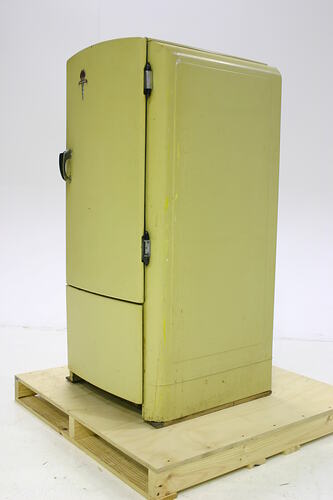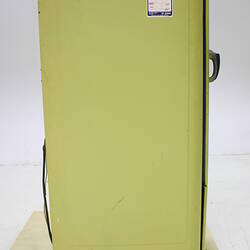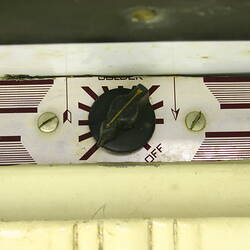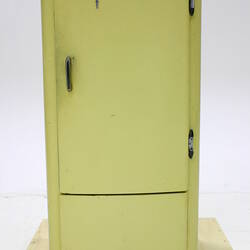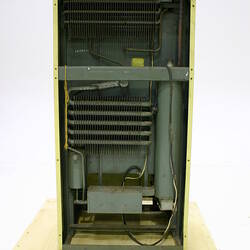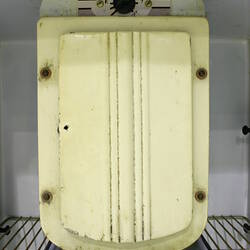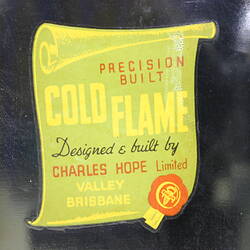Summary
Alternative Name(s): Fridge
Charles Hope, Cold Flame, electric, mustard refrigerator. It is of standard size, with rounded shouldered form, and enamelled metal body. This refrigerator was made by Charles Hope, the Valley, Brisbane, Queensland in 1944-46. It was used in Ballarat, Victoria, Australia, from 1946 - 2001.
This refrigerator is significant because it is one of the very few makes made in Australia by Australian owned companies. It represents Australian technological innovation and reflects an era when Australian industry supported the manufacture of household appliances.
This item was purchased from Patterson & Powell department store in Ballarat around 1946 by the mother of the donors. The mother recently died at age 94. The donors' family were reasonably well off and were relatively early adopters of technology compared to some of the family's friends. The fridge was never serviced and at the time of acquisition was still functioning. It was until recently as the family's Christmas bar fridge.
Physical Description
This is a standard, electric, mustard enamelled, metal refrigerator. DOOR: 3/4 height hinged on the right with two bullet shaped hinges (the lower one is missing its central component). A metal logo is attached at the top of the door, centre-left. There is a removable panel below the door, covering the compression unit. HANDLE- D-shaped with a black, enamelled button on the left. BACK: exposed revealing two grills. INTERIOR: white enamel with black enamel collar to frame and door. A white with black trim enamel drip tray underneath the freezer unit. 3 removable wire shelves, each sitting on 4 rubber pegs. A further 2 pegs top right. A silver-metal light-release button left-middle-centre. FREEZER COMPARTMENT - attached to the back at the top. Top centre is a panel with a temperature dial at its centre. Around the dial are graduating lines emanating from the centre. The door is hinged at right and has a central panel with relief decoration of 5 curved vertical bands. The interior consists of 3 compartments with 2 fixed shelves. DOOR - insulated enamelled metal with a black rubber seal. There are no shelves in the door. Has a "Middy Plug".
Significance
This refrigerator is significant because it is one of the very few makes made in Australia by Australian owned companies. It represents Australian technological innovation and reflects an era when Australian industry supported the manufacture of household appliances.
In addition, this object comes with a provenance that tells an important story about the social history of Australia. This fridge reflects the first wave of consumerism in Australia in the post World War Two era, which was directed toward the kitchen, eg fridges and stoves. Electrical appliances were heavily marketed to the home user from the 1920s, using advertising that claimed electricity would eradicate the drudgery of house-work, especially in a time when servants were becoming hard to find, and was more hygienic. Marketing also pushed the notion of modernism, especially in the 1930s, and tried to persuade homeowners to be 'up to date' and stylish. There was a glamorisation of the housewife at this time, and the success of this marketing is reflected in the fact that women were the main buyers of electrical appliances, particularly young newly wed women such as the donors' mother.
The adoption of electrical appliances was relatively slow because homeowners needed to be in a position to afford to have their house wired for electricity and to purchase the early domestic appliances, all of which was quite expensive. By the end of WW2, however, there was a shift in expectation and access to electrical appliances. In 1944 the Commonwealth Housing Commission stated that 'all future homes should have a radio and fridge as basic equipment'. By 1947 more than 80% of homes in Victoria had been wired for electricity, which facilitated the increased use of electrical appliances at this time. Most larger appliances, however, didn't appear in the majority of homes until the 1950s.
More Information
-
Collection Names
-
Collecting Areas
-
Acquisition Information
Donation from 17 Dec 2001
-
Manufacturer
Charles Hope Limited, 21 Wandoo Street, The Valley, Queensland, Australia, post 1944
Also had an address at Casino Rd, South Lismore, NSW. Australian patent issued May 1944. -
Manufacturer
Charles Hope Ltd
In "The Australasian Manufacturers' Directory" Charles Hope Ltd is listed with both an address in Qld and NSW. -
Place & Date Used
-
Inscriptions
DOOR: Upper left silver and red, metal logo in the shape of a flame. Enamelled in red on a silver banner that crosses the centre of the flame is "COLD FLAME / CHARLES HOPE". BACK: left below top grill, written in white marker "16590D". Right, off-centre, below the top grill is a metal disk "CHARLES HOPE LIMITED/ CHARLES INDUSTRIES PTY LIMITED/ THIS APPARATUS IS COVERED BY THE FOLLOWING PATENTS/ AUSTRALIAN PATENT NO. 118514/ AUSTRALIAN PATENT NO. 80099/ NEW ZEALAND PATENT NO. 87988/ SOUTH AFRICAN PATENT NO. 16544/ INDIA PATENT NO. 30670/ GREAT BRITAIN & UNITED STATES OF AMERICA PATENTS PENDING/ UNIT NUMBER 16590 TYPE D1". Branded across the centre of the fridge "D16590 D16590" INTERIOR: around the temperature dial, in red lettering "COLDER/ OFF". DOOR - top left, paper disk, transferred in gilt, green and black "ASSURES LONG LIFE TO ENAMEL FINISHES/ RUSTPROOFED AND BONDERIZED PRODUCT ATTACHED UNDER LICENCE". Top right paper disk transferred in red, white and black upon a green background "PRECISION BUILT/ COLD FLAME/ Designed & built by (in script)/ CHARLES HOPE Limited/ VALLEY BRISBANE".
-
Brand Names
-
Classification
Domestic life, Food & drink preservation, Appliances - electric
-
Category
-
Discipline
-
Type of item
-
Overall Dimensions
67.8 cm (Length), 69.8 cm (Width), 144.8 cm (Height)
-
Other Dimensions
30.4 cm (Length), 19.7 cm (Width), 31.8 cm (Height)
Freezer Compartment
-
Other Dimensions
7 cm (Length), 56.8 cm (Width), 100 cm (Height)
Door
-
References
A kerosene powered Charles Hope fridge [not this particular fridge] appears in the film "Sunday too far away". It is in a shearer's quarters in the Australian outback. The Australasian Manufacturers Directory Vol 20, issued March 1953, pps 123, 505 * The Australasian Manufacturers Directory 1953-1954 pps 832-836 * The Australasian Manufacturers Directory Vol 21, issued March 1956, pps 131, 537,891 * A history of refrigeration throughout the world, by R Thevenot, translated from French by JC Fidler, International Institute of Refrigeration, 1979
-
Keywords
Australian Manufacturing Industry, Domestic Appliances, Electricity, Refrigeration
